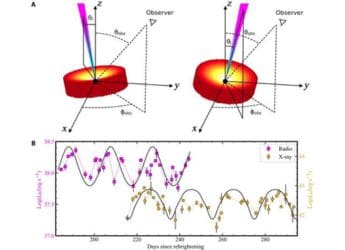- Home
- Science
- Science News
- Scientists Say Solar Flares Are Hotter Than Expected, Could Reach 108 Million Degrees
Scientists Say Solar Flares Are Hotter Than Expected, Could Reach 108 Million Degrees
Solar flares heat ions to 108 million°F, six times hotter than thought, reshaping space weather forecasts and satellite protection.

Photo Credit: NOAA
Sun unleashes strongest 2025 X-class flare, radio blackouts hit regions, heat far hotter than thought
A new study suggests that particles can be thrown by the Sun's strong flares up to 108 million degrees Fahrenheit (60 million degrees Celsius), which is roughly six times hotter than previous estimates. This finding emphasizes the need to update solar storm models and helps solve a long-standing conundrum. Massive explosions known as solar flares can send radiation and particle bursts into space, endangering astronauts and occasionally interfering with communications and satellites. The Astrophysical Journal Letters published the results.
Surprising Findings from Flare Research
According to the researchers led by Alexander Russell at the University of St. Andrews found that during solar flares, charged atoms (ions) can get far hotter than the electrons around them. Using experiments and computer simulations of magnetic reconnection (the process that powers flares), they showed electrons warm up to roughly 10–15 million °C while ions soar past 60 million °C.
Because ions and electrons take minutes to share heat, the super-hot ions persist long enough to smear the spectral fingerprints of elements in the flare's light. The faster-moving ions naturally broaden these spectral lines, potentially resolving why those lines have always appeared wider than theory predicted.
Forecasting Space Weather
Our ability to forecast space weather is greatly altered by the realization that flare ions carry a lot more heat. Flare energy may be underestimated by models that assume a single temperature for all particles. In order to improve warnings for satellites, airlines, and astronauts, the study recommends that future forecasts treat electrons and ions separately.
A "multi-temperature" strategy, which is already popular in other plasma contexts, might allow operators more time to get ready for potentially hazardous solar storms. This theory may be tested by future spacecraft missions that measure the ion temperatures in flares directly.
Get your daily dose of tech news, reviews, and insights, in under 80 characters on Gadgets 360 Turbo. Connect with fellow tech lovers on our Forum. Follow us on X, Facebook, WhatsApp, Threads and Google News for instant updates. Catch all the action on our YouTube channel.
Related Stories
- Samsung Galaxy Unpacked 2025
- ChatGPT
- Redmi Note 14 Pro+
- iPhone 16
- Apple Vision Pro
- Oneplus 12
- OnePlus Nord CE 3 Lite 5G
- iPhone 13
- Xiaomi 14 Pro
- Oppo Find N3
- Tecno Spark Go (2023)
- Realme V30
- Best Phones Under 25000
- Samsung Galaxy S24 Series
- Cryptocurrency
- iQoo 12
- Samsung Galaxy S24 Ultra
- Giottus
- Samsung Galaxy Z Flip 5
- Apple 'Scary Fast'
- Housefull 5
- GoPro Hero 12 Black Review
- Invincible Season 2
- JioGlass
- HD Ready TV
- Laptop Under 50000
- Smartwatch Under 10000
- Latest Mobile Phones
- Compare Phones
- Redmi Note 15 5G
- Redmi Note 15 Pro 5G
- Redmi Note 15 Pro+ 5G
- Lava Play Max
- Poco C85 5G
- Honor Magic 8 Lite
- Jolla Phone
- Realme P4x 5G
- Asus ProArt P16
- MacBook Pro 14-inch (M5, 2025)
- OnePlus Pad Go 2
- Poco Pad M1
- Just Corseca Skywatch Pro
- Honor Watch X5
- Acerpure Nitro Z Series 100-inch QLED TV
- Samsung 43 Inch LED Ultra HD (4K) Smart TV (UA43UE81AFULXL)
- Asus ROG Ally
- Nintendo Switch Lite
- Haier 1.6 Ton 5 Star Inverter Split AC (HSU19G-MZAID5BN-INV)
- Haier 1.6 Ton 5 Star Inverter Split AC (HSU19G-MZAIM5BN-INV)

















